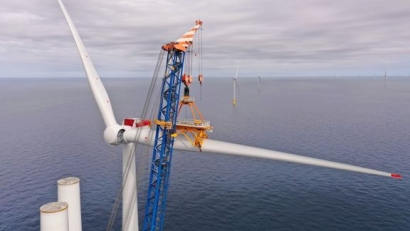Renewable energy is a central part of the answer to both of these challenges, and the Danish part of the North Sea has the potential to drive much of Europe’s green transformation.
Denmark has taken the lead in finding ways to realize the enormous renewable potential of the North Sea. The decision of the Danish Parliament to build an energy island in the North Sea marks a new era in the transition to renewable energy, and if the island is designed correctly, it can become the key to the green transformation of Denmark and the Europe.
In spring 2021, Ørsted and ATP joined forces to develop a groundbreaking sustainable concept for the upcoming tender for an energy island in the Danish North Sea. Ørsted and ATP – together with their partners Aarsleff, Bouygues Construction and Van Oord – will present the ideas behind the concept of the partnership, called “North Sea Energy Island”.
“Ørsted, ATP and its partners have a vision to build more than just an island. We want to create an island in constant development. A future-proof island with unlimited space for innovation and adaptation as you go. that the green transformation is evolving”, the companies say.
The North Sea Energy Island consists of a small artificial island, which can be expanded with flexible modules that can be added and replaced as needed. The modules are built onshore and connected to the North Sea Energy Island, meaning the island can easily be upgraded to accommodate over 10GW of offshore wind energy, which is the ambition present in Denmark. It can also be adapted to accommodate rapid developments in Power-to-X and other technologies in 2030 and 2050.
Flexible modules are the most scalable solution. It is also the direct way to provide large amounts of green energy as quickly as possible. Modules can be built on land, while reclaimed island and offshore wind turbines are built at sea, which will result in considerable time savings during the construction phase. With this flexible and modular concept, Ørsted and ATP estimate that the energy island in the North Sea can provide green energy two years before an inflexible and confined island.
Learn more about the concept here.
Rasmus Errboe, Head of Continental Europe Region at Ørsted, said: “We are ready to deliver an island that embraces the rapid development of renewable technologies and enables an intensification of green transformation. With our approach, the energy island in the North Sea will be more than just an island.
“We believe that our modular concept offers the best conditions to ensure that the energy island will remain relevant in 2030 and 2050, and we look forward to continued dialogue with authorities and decision-makers on the “energy island of the sea of the sea”. North”. .”
Claus Wiinblad, Senior Vice President at ATP, said: “We believe that the flexibility of our concept is a great advantage and creates a very good climate-friendly energy solution, which is absolutely crucial when embarking on an investment at long term like this, and therefore there is a basis to create a reasonable risk-adjusted return.At the same time, we are investing in the green transition, and in this way “The North Sea Energy Island” corresponds both to the ambitions climate change and ATP’s goal of creating the best retirements possible.
Jesper Kristian Jacobsen, CEO of Aarsleff, which leads the construction consortium on the “energy island in the North Sea”, says: “With this concept, we have taken well-known technologies and construction methods and combined in a new, intelligent and revolutionary way suited to the harsh environment of the North Sea. This means we can build an energy island that can sustain a huge ramp-up of offshore wind and is ready to meet future needs from the start.
Besides Aarsleff, the team of contractors includes Van Oord and Bouygues Construction.

